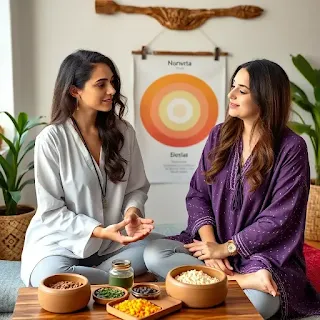In the fast-paced, digitally-driven world of 2025, many are seeking balance—not just in their schedules, but in their bodies, minds, and energy. Enter: Ayurveda, a 5,000-year-old Indian healing system that’s making a major comeback.
But this isn’t the Ayurveda your grandmother spoke about. This is Ayurveda 2.0—adapted, reinterpreted, and scientifically validated to meet today’s health challenges.
From bio-individual diets to mental clarity rituals, Ayurveda offers not just healing—but a blueprint for vibrant, sustained health.
🌟 What is Ayurveda, Really?
Ayurveda is a Sanskrit word meaning "The Science of Life." It focuses on achieving harmony between your mind, body, and spirit through personalized habits, diet, herbs, and lifestyle.
The Core Concept:
Every individual has a unique constitution or “Prakriti”, based on the three Doshas:
- Vata (Air + Space): movement, creativity, flexibility
- Pitta (Fire + Water): bolism, focus, ambition
- Kapha (Earth + Water): stability, nourishment, calm
When these doshas are imbalanced, illness and emotional unrest occur.
🔬 2025 Breakthrough: Ayurveda Meets Science
🔎 Research Update:
In a 2024 meta-analysis published in Frontiers in Pharmacology, Ayurvedic herbs like Ashwagandha, Triphala, and Turmeric showed comparable results to pharmaceuticals for managing stress, digestive issues, and inflammation—without side effects.
Today, we see:
- AI-backed Dosha quizzes for accurate assessments
- Smart herbal dispensers that prepare custom tonics
- Wearables tracking circadian rhythms to optimize daily routines based on Ayurveda
- Ayurvedic apps syncing your food, sleep, and detox cycles
Ayurveda is no longer just intuitive. It’s data-informed, lab-tested, and clinically respected.
🧘♀️ 3 Modern Ayurvedic Practices That Work in 2025
1. Dinacharya (Daily Routine) 2.0
People now blend traditional Ayurvedic routines with biohacking habits. Think:
- Oil pulling + cold exposure
- Morning meditation + red light therapy
- Abhyanga massage + lymphatic drainage tools
2. Ayurvedic Nutrition with Local Foods
Instead of traditional Indian-only foods, practitioners now adapt diets with:
- Quinoa instead of white rice for Kapha types
- Avocado and ghee combinations for Vata nourishment
- Cooling herbs with mint and aloe for fiery Pittas
3. Ayurvedic Mental Health Care
2025 sees a rise in Ayurvedic psychotherapy—where doshas inform mental health strategies.
For example:
- Vata types manage anxiety with warm routines and grounding herbs
- Pitta types soothe anger through cooling foods and breathwork
- Kapha types combat depression with energizing rituals and light diets
🌿 Top 5 Ayurvedic Herbs Backed by Science
| Herb | Benefits | Best For |
|---|---|---|
| Ashwagandha | Reduces stress, boosts stamina | Vata & Pitta types |
| Triphala | Detoxifies the gut, improves digestion | All doshas |
| Brahmi | Enhances memory, reduces anxiety | Pitta, Vata |
| Shatavari | Hormone balancing, especially in women | Vata, Pitta |
| Turmeric (Curcumin) | Anti-inflammatory, immune support | Kapha & Pitta |
All of these are now available in clinically dosed, sustainably harvested formats—no fillers, no toxins.
⚖️ Personalized Ayurveda: A New Wellness Era
Thanks to genetic testing and dosha profiling, Ayurveda is becoming ultra-personalized.
Apps like AyurIQ, Vedaflow, and SattvaTrack now integrate your:
- DNA results
- Wearable sleep and HRV data
- Gut microbiome tests
- Daily mood and energy logs
This allows practitioners to recommend herbs, foods, and lifestyle changes that work with your body—not against it.
🙋♀️ FAQs About Ayurveda in 2025
Q1: Can Ayurveda help with chronic stress and burnout?
A: Yes. With adaptogenic herbs like Ashwagandha and lifestyle practices like Abhyanga and meditation, Ayurveda offers deep nervous system support.
Q2: Do I have to be vegetarian to follow Ayurveda?
A: Not necessarily. Modern Ayurveda focuses on digestibility, ethical sourcing, and seasonal eating, which may include high-quality meats for certain dosha types.
Q3: Is Ayurveda safe with Western medicine?
A: Yes—but always work with an Ayurvedic practitioner and inform your doctor to avoid herb-drug interactions.
Q4: How do I find my Dosha accurately?
A: The best way is through a consultation with a certified Ayurvedic doctor who can read your pulse, tongue, and ask guided questions. Digital dosha quizzes are a good start but may lack depth.
Q5: Can I use Ayurveda for skincare and beauty?
A: Absolutely! Ayurveda emphasizes skin health through dosha-based oils, herbs like neem and manjistha, and internal balance for radiant skin.
💬 Final Word: Ayurveda Is the Future—Because It Honors the Past
In 2025, wellness is no longer one-size-fits-all. It’s about alignment, intention, and respecting your body’s unique blueprint.
Ayurveda offers the timeless tools—and modern science now validates their power.
So whether you're sipping turmeric tea or syncing your day with the sun, remember:
Your body is your guide, and Ayurveda helps you listen.


Post a Comment